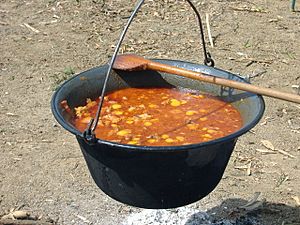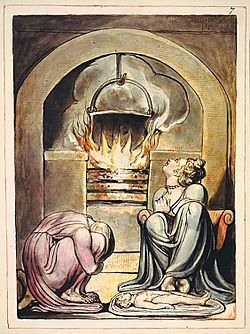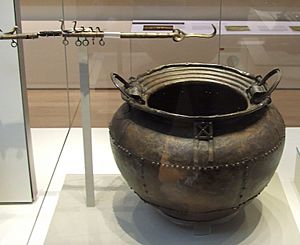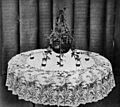Cauldron facts for kids

A cauldron is a very large metal pot or kettle. It's usually used for cooking or boiling things over an open fire. Cauldrons often have a wide opening and a curved handle, like an arc, to hang them.
Contents
Cauldrons in Stories and Beliefs

Today, cauldrons aren't used much for everyday cooking in many countries. But they are very famous in stories and myths!
Witches and Magic
When you think of a cauldron, you might imagine a witch stirring a bubbling potion. This idea is very common in stories, like in William Shakespeare's play Macbeth. In these tales, witches often use cauldrons to mix their magical ingredients.
In Irish folklore, there's a fun belief that leprechauns hide their gold and treasure at the end of a rainbow, often near a cauldron!
Ancient Myths and Modern Beliefs
Some modern spiritual beliefs, like Wicca, connect the cauldron to ancient Celtic mythology. For example, the cauldron is sometimes linked to the goddess Cerridwen.
Old Welsh legends also tell of magical cauldrons. One famous story from the Mabinogion is about the Pair Dadeni, or "Cauldron of Rebirth." This magical cauldron could bring dead warriors back to life! However, these warriors couldn't speak and might not have had souls. They could go back into battle until they were killed again.
In Wicca and other similar belief systems, cauldrons are still used in magical practices. They are often made of cast iron. People might use them to burn incense, mix special herbs, or burn papers with wishes written on them. Cauldrons can represent the idea of holding things, like the Earth, and are seen as a tool for work. You can often find cauldrons in stores that sell spiritual items, sometimes with special symbols carved into them.
Famous Cauldrons in History and Myth
The Holy Grail from the King Arthur stories is sometimes called a "cauldron." Even though the Grail is usually thought of as a small cup, this connection might come from older Celtic myths about magical cauldrons.
In Chinese history, a type of ancient pot called a "ding" is often called a cauldron. Owning these dings was a sign of great power and control over the land. So, the word "ding" often means power itself. Asking "inquiring of the ding" means seeking power.
Here are some real cauldrons found by archaeologists:
- The Gundestrup cauldron: Made around 200 or 100 BC, found in Denmark.
- A Bronze Age cauldron: Found in Hassle, Sweden.
- The cauldron where the Olympic Flame burns: This is lit during the Olympic Games.
Here are some famous cauldrons from myths and stories:
- Dagda's Cauldron
- The Cauldron of Dyrnwch the Giant
- Pair Dadeni
- Cauldron of Hymir
Images for kids
-
The Garden of Earthly Delights, bird-headed monster or the "Prince of Hell" (close-up head), a name derived from the cauldron he wears on his head.
-
African American woman and child outdoors, standing by boiling cauldron of water, c. 1901.
See also
 In Spanish: Caldero para niños
In Spanish: Caldero para niños








